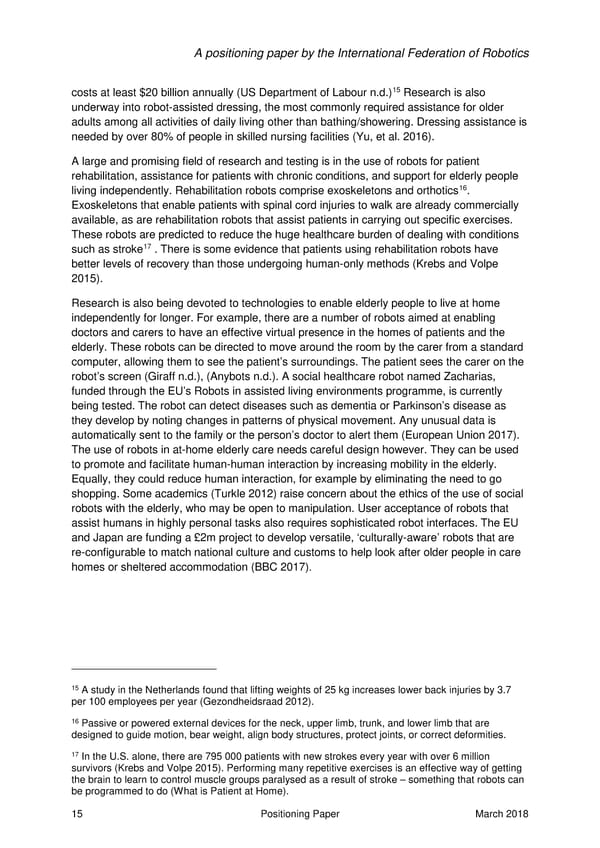A positioning paper by the International Federation of Robotics costs at least $20 billion annually (US Department of Labour n.d.)15 Research is also underway into robot-assisted dressing, the most commonly required assistance for older adults among all activities of daily living other than bathing/showering. Dressing assistance is needed by over 80% of people in skilled nursing facilities (Yu, et al. 2016). A large and promising field of research and testing is in the use of robots for patient rehabilitation, assistance for patients with chronic conditions, and support for elderly people living independently. Rehabilitation robots comprise exoskeletons and orthotics16. Exoskeletons that enable patients with spinal cord injuries to walk are already commercially available, as are rehabilitation robots that assist patients in carrying out specific exercises. These robots are predicted to reduce the huge healthcare burden of dealing with conditions such as stroke17 . There is some evidence that patients using rehabilitation robots have better levels of recovery than those undergoing human-only methods (Krebs and Volpe 2015). Research is also being devoted to technologies to enable elderly people to live at home independently for longer. For example, there are a number of robots aimed at enabling doctors and carers to have an effective virtual presence in the homes of patients and the elderly. These robots can be directed to move around the room by the carer from a standard computer, allowing them to see the patient’s surroundings. The patient sees the carer on the robot’s screen (Giraff n.d.), (Anybots n.d.). A social healthcare robot named Zacharias, funded through the EU’s Robots in assisted living environments programme, is currently being tested. The robot can detect diseases such as dementia or Parkinson’s disease as they develop by noting changes in patterns of physical movement. Any unusual data is automatically sent to the family or the person’s doctor to alert them (European Union 2017). The use of robots in at-home elderly care needs careful design however. They can be used to promote and facilitate human-human interaction by increasing mobility in the elderly. Equally, they could reduce human interaction, for example by eliminating the need to go shopping. Some academics (Turkle 2012) raise concern about the ethics of the use of social robots with the elderly, who may be open to manipulation. User acceptance of robots that assist humans in highly personal tasks also requires sophisticated robot interfaces. The EU and Japan are funding a £2m project to develop versatile, ‘culturally-aware’ robots that are re-configurable to match national culture and customs to help look after older people in care homes or sheltered accommodation (BBC 2017). 15 A study in the Netherlands found that lifting weights of 25 kg increases lower back injuries by 3.7 per 100 employees per year (Gezondheidsraad 2012). 16 Passive or powered external devices for the neck, upper limb, trunk, and lower limb that are designed to guide motion, bear weight, align body structures, protect joints, or correct deformities. 17 In the U.S. alone, there are 795 000 patients with new strokes every year with over 6 million survivors (Krebs and Volpe 2015). Performing many repetitive exercises is an effective way of getting the brain to learn to control muscle groups paralysed as a result of stroke – something that robots can be programmed to do (What is Patient at Home). 15 Positioning Paper March 2018
 Robots & the Workplace of the Future Page 15 Page 17
Robots & the Workplace of the Future Page 15 Page 17